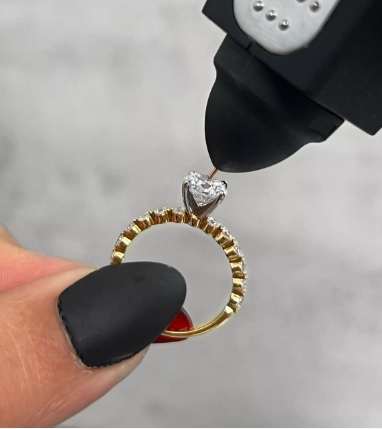The very first non-natural diamonds were grown by General Electric in December 1954. But, due to the high cost of their creation and low customer demand, they were considered a success for science and not the jewelry industry.
Later, in the 1970s and 1980s, lab created diamonds finally became widely available and desirable to shoppers. However, they weren’t completely identical to the real deal, remaining small and of lower quality than natural stones.
Today, lab diamonds account for 2 to 3% of the market for engagement rings. And, they’re so close to authentic that even the experts sometimes have trouble telling them apart.
So, do lab created diamonds pass a diamond tester?
The simple answer is yes! Keep reading to learn all about this affordable and ethical alternative to mined stones.
What Exactly Are Lab Created Diamonds?
Most lab grown diamonds are created through a process called chemical vapor deposition, or CVD.
This method uses carbon gas to heat a diamond seed (a tiny authentic mined stone) in a sealed chamber. The combination of heat and pressure applied during this process causes carbon molecules to stick to the seed, growing into a larger diamond.
Unlike lab created diamonds of the past, CVD stones have few flaws or inclusions, and are sold in a wide variety of colors, including dazzling bright white.
Because CVD gives scientists great control over the properties of the diamonds that they are growing, it is now possible to produce large, gem-quality stones. And, as CVD requires lower pressure and temperature points than previous diamond production methods, the process is far less costly.
For customers, this adds up to high-quality diamonds at affordable prices. And, you’ll know for certain where your stone came from and how it was sourced.
Can You Tell the Difference Between a Natural Diamond and a Lab Diamond?
No, and neither will anybody else. To the naked eye, lab diamonds look identical to those that took billions of years to form.
They carry all the traditional fire associated with one of the planet’s most precious stones, and you’ll shop for them the same way, using the 4C’s.
Lab diamonds can also be used in all the same settings as mined stones. So, if you’re in the market for the perfect engagement ring, this is an outstanding option that is nearly guaranteed to fit your budget.
Because lab diamonds refract light just as well as natural stones, they’ll look great in a wide variety of settings. They pair perfectly with all shades of gold, and can even be used among mined diamonds for a dramatic effect! For example, as a solitaire set atop a dazzling backdrop of tiny pavé or even micro pavé diamonds.
Laboratory grown diamonds also come in a surprising assortment of exotic colors, including blue, white, and even yellow. These perfectly mimic rare colored diamonds, which are among some of the most sought-after stones on the market.
Do Lab Diamonds Pass a Diamond Tester?
A diamond tester is a hand-held pen that measures thermal and electrical conductivity. The tool’s metal point is applied to the stone that it is testing, and a mild electrical current is passed through it. How quickly this electricity moves through the stone can tell whether or not it is an authentic diamond.
In most cases, today’s lab grown diamonds are so chemically similar to those formed naturally, that the tester cannot distinguish one from the other. In some cases, however, lab diamonds contain less nitrogen than natural diamonds.
A diamond tester will absolutely identify some imitation stones that are not authentic lab created diamonds, such as CZ, or Cubic Zirconia.
This pen test isn’t the only way that jewelers inspect and assess diamonds. They also use visual clues such as measuring how much light each stone refracts, and how hard its surface is.
Examining jewels under magnification can rule out some diamond substitutes like Moissanite, white sapphire, and white topaz. These won’t refract both colored and white light, and they aren’t among the hardest materials on planet earth.
Your jeweler should also be able to locate a natural or lab diamond’s certificate number under their microscope. Replicas like CZ and Moissanite won’t have this.
How To Clean a Lab Created Diamond
Cleaning a lab created diamond is surprisingly similar to cleaning a mined stone.
Soak your jewelry in a small dish filled with mild dish soap and warm water for 10-20 minutes. Then, use a soft toothbrush to give it a gentle all-over scrub. This will help to break apart any buildup. Once you’ve thoroughly cleaned your diamonds, rinse them under running water to remove any soap residue.
Cleaning your diamonds at home is easy enough, but you should also take them in for professional care at least once a year. An expert jeweler can perform deep cleaning and repairs that would be impossible to do on your own.
Shop With the Best Jewelry Store in Atlanta
Now that you know a bit more about lab created diamonds, you’re ready to shop with confidence. And, no matter which you prefer – lab grown or natural stones, there’s only one place to go for the finest quality and selection in town.
Masina Diamonds offers the very best natural and lab diamonds in Atlanta, and we’ve been serving the area since 1984. Our family owned and operated business only offers the highest quality GIA certified stones, and we have hundreds of custom ring settings and loose diamonds on hand to choose from.
Book a personal consultation or stop by our showroom to learn more about our customer service philosophy and quality guarantee.
Article Source: https://masinadiamonds.com/do-lab-created-diamonds-pass-a-diamond-tester/

